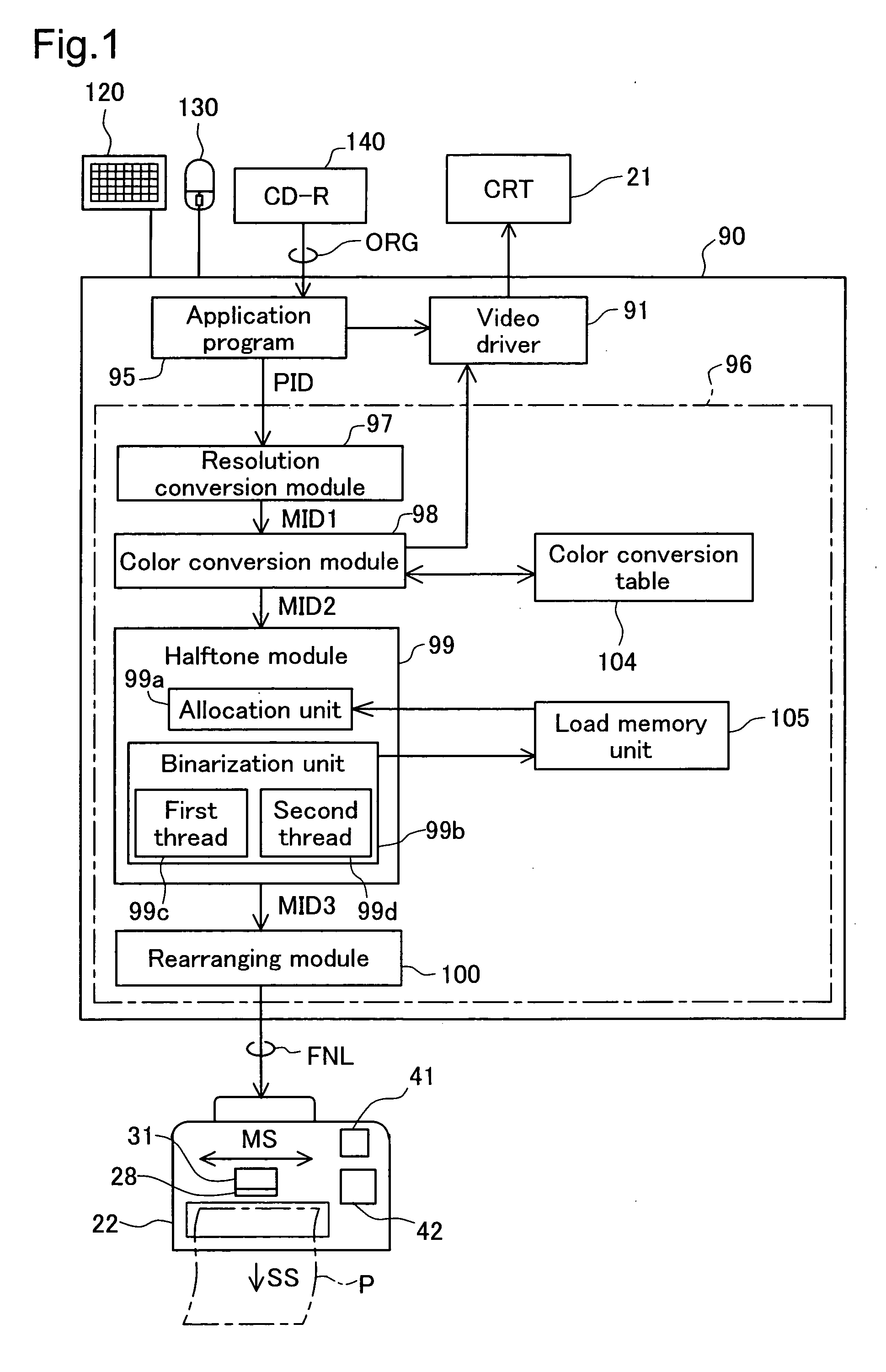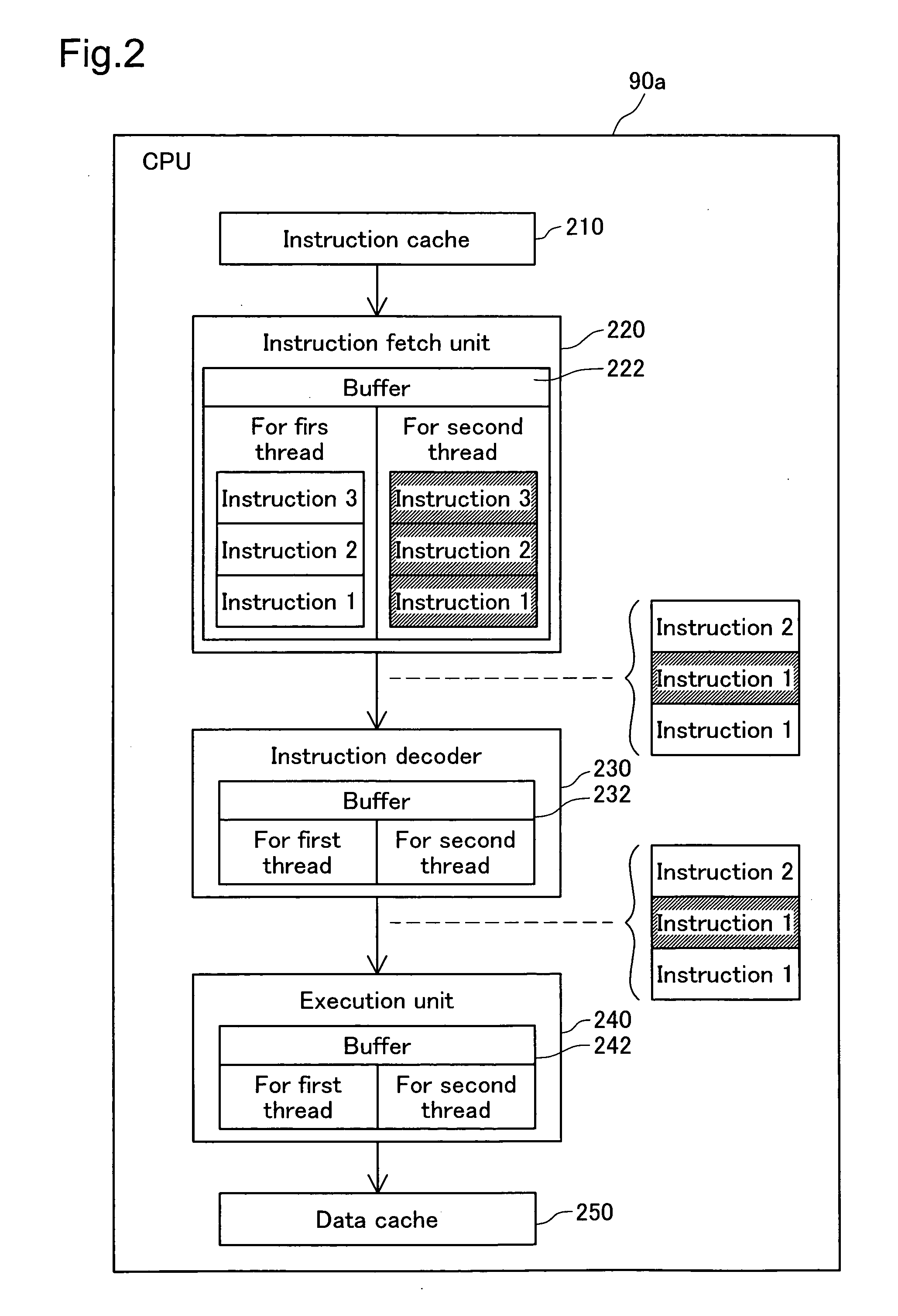Load allocation when executing image processing using parallel processing
a technology of image processing and load allocation, applied in the field of parallel image processing, can solve the problems of reducing the possibility of processing efficiency drop, and achieve the effects of finely equalizing the variance of loads, reducing load differences, and reducing load differences
- Summary
- Abstract
- Description
- Claims
- Application Information
AI Technical Summary
Benefits of technology
Problems solved by technology
Method used
Image
Examples
first embodiment
B. First Embodiment
B1. Overall Constitution of the Device
[0044]FIG. 1 is a block diagram showing the software configuration of the printing system of the first embodiment. With a computer 90, an application program 95 operates under a specified operating system. Also, a video driver 91 and the printer driver 96 are incorporated in the operating system.
[0045] The application program 95 reads original image data ORG consisting of the three color components red (R), green (G), and blue (B) from a CD-R 140, according to user instructions input from a mouse 130 or a keyboard 120. Then, processing such as image retouching is performed on the original image data ORG according to the user instructions. The application program 95 displays processed images on the CRT display 21 via the video driver 91. Also, when printing instructions are received from the user, the application program 95 issues printing instructions to the printer driver 96, and supplies a processed image as initial image...
second embodiment
C. Second Embodiment
[0098] The second embodiment is different from the first embodiment in terms of the method of allocation of sequence position of the middle group G2 in FIG. 5. Also, at steps S150 and S180 in FIG. 3, each unit HT process segment is executed in an order that is different from the order of allocation to each thread with step S70 in FIG. 5. The other points are the same as with the first embodiment.
[0099]FIGS. 7A to 7C show the procedure for allocation of the unit HT process segments for the second embodiment. FIG. 7A is a drawing expressing the estimated load of each unit HT process segment. The notations in the drawing are the same as those in FIG. 6A. With the second embodiment, the allocation of the sequence position within the middle group G2 at step S40 of FIG. 5 is performed in sequence of the biggest estimated load, regardless of whether each unit HT process segment is the first-type of unit HT process segment and the second-type of unit HT process segment....
third embodiment
D. Third Embodiment
[0104]FIG. 9 shows the unit HT process segments allocated to the first through third threads for the third embodiment. With the third embodiment, there are three threads. The other points are the same as with the first embodiment.
[0105] At step S60 in FIG. 5, the allocation of sequence positions to the unit HT process segments is done as shown in FIG. 6B. Note that with the third embodiment, the number of the start group G1 unit HT process segments is lower than the number of threads. After that, at step S70 of FIG. 5, the unit HT process segments are allocated. The method of the allocation is the same as that of the first embodiment. Specifically, first, the start group G1 unit HT process segments are allocated to each thread, and after that, the middle group and the end group unit HT process segments are allocated to the thread with the lowest total load of allocated unit HT process segments according to the priority sequence.
[0106] With this kind of aspect as...
PUM
 Login to View More
Login to View More Abstract
Description
Claims
Application Information
 Login to View More
Login to View More - R&D
- Intellectual Property
- Life Sciences
- Materials
- Tech Scout
- Unparalleled Data Quality
- Higher Quality Content
- 60% Fewer Hallucinations
Browse by: Latest US Patents, China's latest patents, Technical Efficacy Thesaurus, Application Domain, Technology Topic, Popular Technical Reports.
© 2025 PatSnap. All rights reserved.Legal|Privacy policy|Modern Slavery Act Transparency Statement|Sitemap|About US| Contact US: help@patsnap.com



